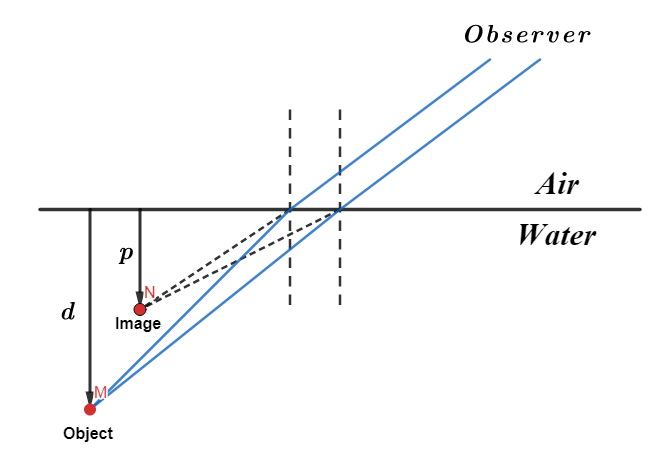
An object in a denser medium when viewed from a rarer medium appears to be raised. The shift is maximum for,
(A). Red light
(B). Violet light
(C). Yellow light
(D). Green light
Answer
579.9k+ views
- Hint: We know that due to refraction the light coming from a denser to rare medium will bend towards the normal. So this can cause an apparent shift. Also, the refractive index of a material is a function of the wavelength of light. Which means the refractive index of the same material varies for different wavelengths. Since violet light has the minimum wavelength, the refractive index for the violet light will be more.
Complete step-by-step solution -
When the light from an object placed at a depth d in water enters the air, the light bends away from the normal due to refraction. So when this light ray enters our eyes, the eyes will see the object originally situated at the depth d at an apparent depth p since the eyes always traces out the linear path taken by light into the water, it does not take into account that the light was refracted at the surface. So this apparent shift in depth makes us believe that the object in denser medium has been raised for an observer in a rarer medium. The relative refractive index can be calculated using apparent and real depth,
$\text{n}=\dfrac{\text{Real Depth}}{\text{Apparent Depth}}$

The shift in this case is maximum for violet light since maximum refraction is suffered by violet light when it travels from denser to rarer medium.
So the answer to the question is option (B)- Violet light.
Note: When an object in denser medium is viewed along the normal from a rare medium, the apparent shift in depth is zero.
The least refracted light will be the red light, since the red light has the maximum wavelength in the visible spectrum so the material shows the least refractive index for the red light. Apparent shifts will also be minimum for red light.
Complete step-by-step solution -
When the light from an object placed at a depth d in water enters the air, the light bends away from the normal due to refraction. So when this light ray enters our eyes, the eyes will see the object originally situated at the depth d at an apparent depth p since the eyes always traces out the linear path taken by light into the water, it does not take into account that the light was refracted at the surface. So this apparent shift in depth makes us believe that the object in denser medium has been raised for an observer in a rarer medium. The relative refractive index can be calculated using apparent and real depth,
$\text{n}=\dfrac{\text{Real Depth}}{\text{Apparent Depth}}$

The shift in this case is maximum for violet light since maximum refraction is suffered by violet light when it travels from denser to rarer medium.
So the answer to the question is option (B)- Violet light.
Note: When an object in denser medium is viewed along the normal from a rare medium, the apparent shift in depth is zero.
The least refracted light will be the red light, since the red light has the maximum wavelength in the visible spectrum so the material shows the least refractive index for the red light. Apparent shifts will also be minimum for red light.
Recently Updated Pages
Master Class 12 Business Studies: Engaging Questions & Answers for Success

Master Class 12 Economics: Engaging Questions & Answers for Success

Master Class 12 English: Engaging Questions & Answers for Success

Master Class 12 Maths: Engaging Questions & Answers for Success

Master Class 12 Social Science: Engaging Questions & Answers for Success

Master Class 12 Chemistry: Engaging Questions & Answers for Success

Trending doubts
What are the major means of transport Explain each class 12 social science CBSE

Which are the Top 10 Largest Countries of the World?

Draw a labelled sketch of the human eye class 12 physics CBSE

How much time does it take to bleed after eating p class 12 biology CBSE

Explain sex determination in humans with line diag class 12 biology CBSE

Differentiate between homogeneous and heterogeneous class 12 chemistry CBSE




